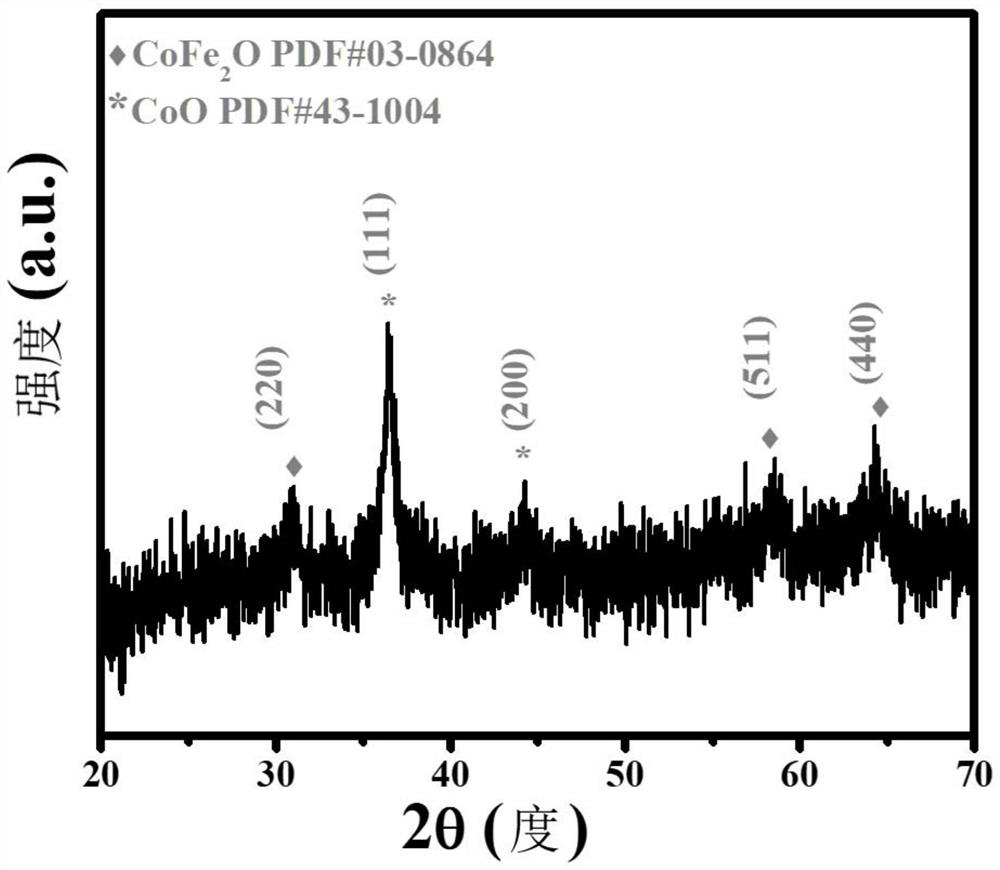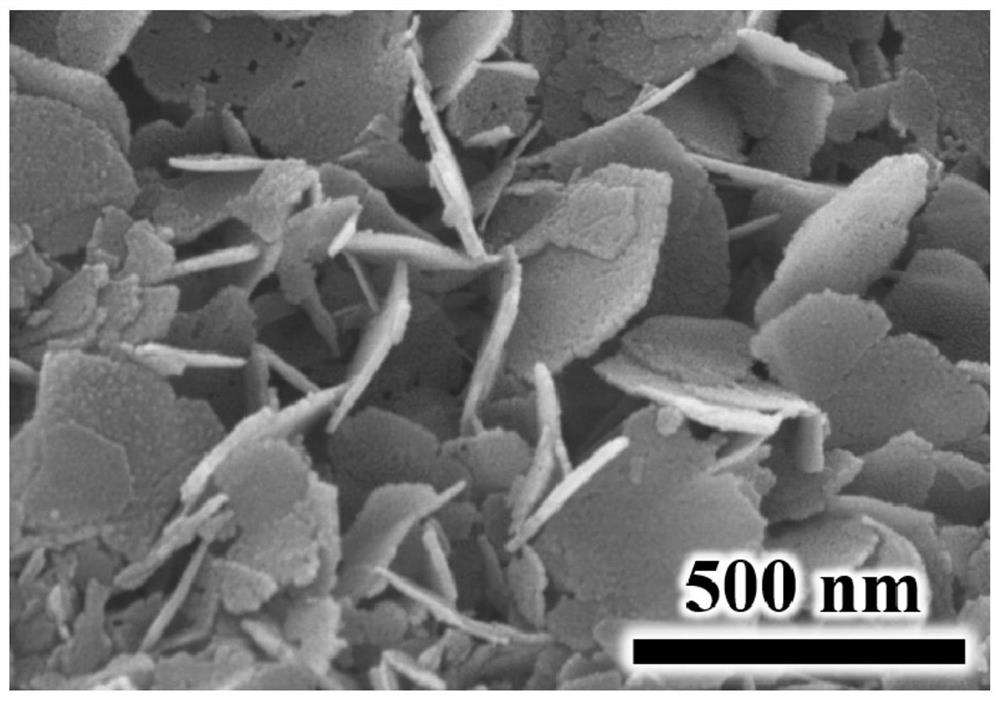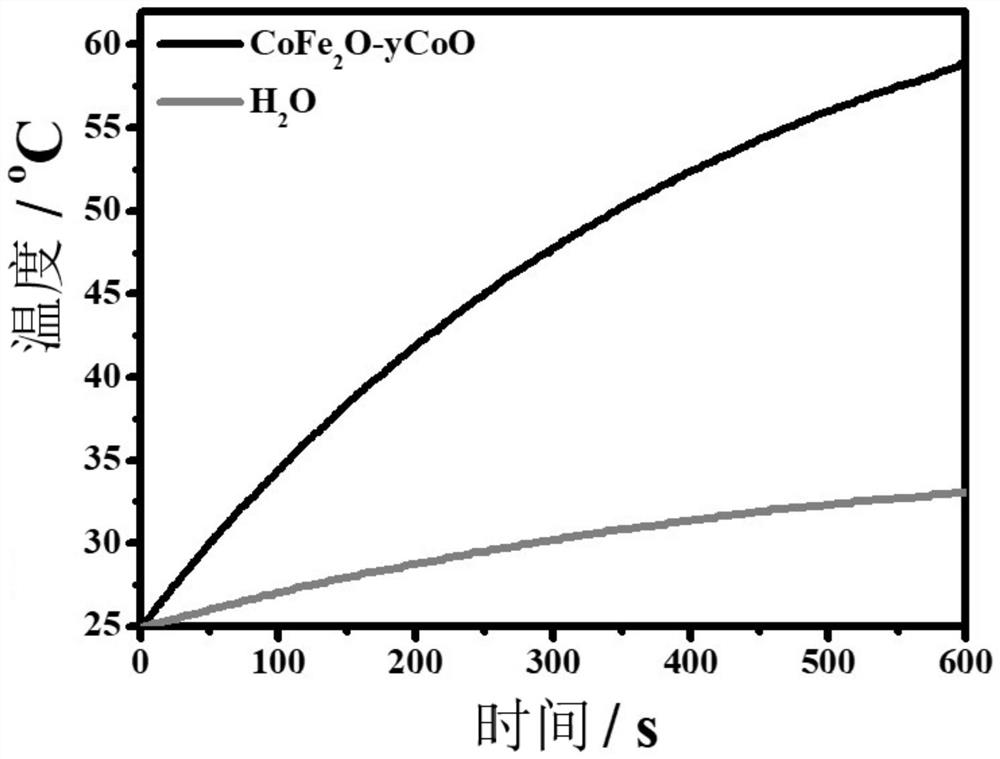Heterojunction nano material and preparation and application thereof
A nanomaterial and heterojunction technology, applied in nanotechnology, nanotechnology, nanomedicine, etc., can solve problems that are rarely reported, and achieve the effects of low toxicity, wide application prospects, and good cancer treatment effect
- Summary
- Abstract
- Description
- Claims
- Application Information
AI Technical Summary
Problems solved by technology
Method used
Image
Examples
Embodiment 1
[0032] a CoFe 2 o 4 - The preparation of yCoO heterojunction nanomaterials, the steps are as follows:
[0033] 1) Co(NO 3 ) 2 ·6H 2 O(0.003mol), Fe(NO 3 ) 3 9H 2 Solution A was prepared by dissolving O (0.001 mol) in 30 mL of deionized water.
[0034] 2) Na 2 CO 3 (0.002mol), NaOH (0.35g) were dissolved in 30mL of deionized water to obtain solution B.
[0035] 3) Slowly add the solution B prepared in step 2) to the solution A prepared in step 1), keep the pH of the solution = 8, mechanically stir the reaction at 80° C. for 24 hours, and centrifuge at 8000 rpm to obtain CoFe-LDH nanosheets.
[0036] 4) Put the CoFe-LDH nanosheets prepared in step 3) into a tube furnace, and calcine them at 500°C for 2 hours in a nitrogen atmosphere to obtain heterojunction nanomaterials, dissolve them in an acidic solution, and perform inductively coupled plasma Emission spectrometer measures the content of Co element and Fe element, as table 1, obtains CoFe 2 o 4The ratio to CoO i...
Embodiment 2
[0041] a CoFe 2 o 4 - The preparation of yCoO heterojunction nanomaterials, the steps are as follows:
[0042] 1) Co(NO 3 ) 2 ·6H 2 O(0.002mol), Fe(NO 3 ) 3 9H 2 Solution A was prepared by dissolving O (0.001 mol) in 30 mL of deionized water.
[0043] 2) Na 2 CO 3 (0.002mol), NaOH (0.35g) were dissolved in 30mL of deionized water to obtain solution B.
[0044] 3) Slowly add the solution B prepared in step 2) to the solution A prepared in step 1), keep the pH of the solution = 8, mechanically stir the reaction at 80° C. for 12 hours, and centrifuge at 8000 rpm to obtain CoFe-LDH nanosheets.
[0045] 4) Put the CoFe-LDH nanosheets prepared in step 3) into a tube furnace, and calcine them at 500°C for 2 hours in a nitrogen atmosphere to obtain heterojunction nanomaterials, dissolve them in an acidic solution, and perform inductively coupled plasma Emission spectrometer measures the content of Co element and Fe element, as table 1, obtains CoFe 2 o 4 The ratio to CoO ...
Embodiment 3
[0048] a CoFe 2 o 4 - The preparation of yCoO heterojunction nanomaterials, the steps are as follows:
[0049] 1) Co(NO 3 ) 2 ·6H 2 O(0.003mol), Fe(NO 3 ) 3 9H 2 Solution A was prepared by dissolving O (0.001 mol) in 30 mL of deionized water.
[0050] 2) Na 2 CO 3 (0.002mol), NaOH (0.35g) were dissolved in 30mL of deionized water to obtain solution B.
[0051] 3) Slowly add the solution B prepared in step 2) to the solution A prepared in step 1), keep the pH of the solution = 8, mechanically stir the reaction at 80° C. for 12 hours, and centrifuge at 8000 rpm to obtain CoFe-LDH nanosheets.
[0052] 4) Put the CoFe-LDH nanosheets prepared in step 3) into a tube furnace, and calcine them at 400°C for 2 hours in a nitrogen atmosphere to obtain heterojunction nanomaterials, dissolve them in an acidic solution, and perform inductively coupled plasma The content of Co element and Fe element is measured by emission spectrometer to obtain CoFe 2 o 4 The ratio to CoO is ab...
PUM
| Property | Measurement | Unit |
|---|---|---|
| size | aaaaa | aaaaa |
| thickness | aaaaa | aaaaa |
| specific surface area | aaaaa | aaaaa |
Abstract
Description
Claims
Application Information
 Login to View More
Login to View More - R&D
- Intellectual Property
- Life Sciences
- Materials
- Tech Scout
- Unparalleled Data Quality
- Higher Quality Content
- 60% Fewer Hallucinations
Browse by: Latest US Patents, China's latest patents, Technical Efficacy Thesaurus, Application Domain, Technology Topic, Popular Technical Reports.
© 2025 PatSnap. All rights reserved.Legal|Privacy policy|Modern Slavery Act Transparency Statement|Sitemap|About US| Contact US: help@patsnap.com



